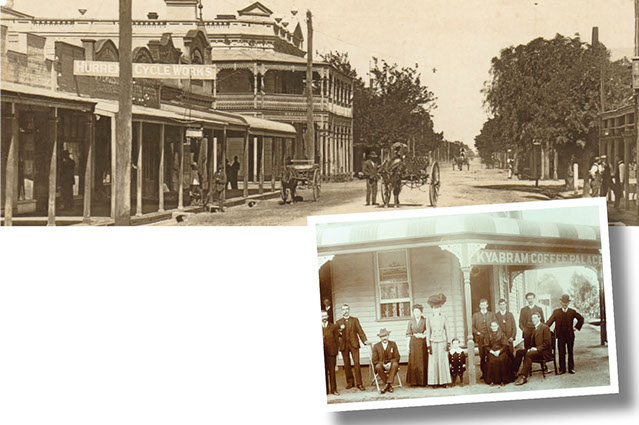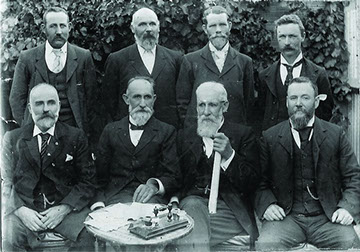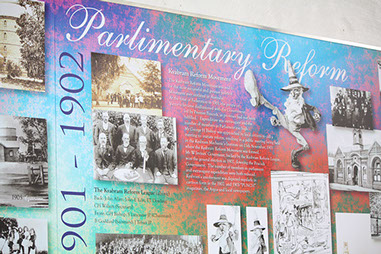KYABRAM 3620


A Brief History
of Kyabram
Kyabram was formerly part of the Wyuna Estate of which M. F. Scobie was recorded as the first squatter in 1840. From 1869 to 1872 the area was in the name of James McBain and was used as a sheep run. Settlement began in1873 when land became open for selection under the 1869 Lands Settlement Act.
The district was thickly forested, the land was harsh and dry and the nearest source of water was the squatter’s tank to the south of the town, with the Goulburn the closest river. Kyabram was only one of a few small settlements at that time, with Henley 3 miles South, Pine Grove one mile North-West, Taripta 3 miles North-east, and Lancaster to the East.
In the early 1880’s Henley appeared to be the focal area of the District where most activities of the time were centred. Henley was described as having the “Gatehouse Hotel”, a General Store and Post Office, Saleyards, Hall, Blacksmith, Butcher’s shop, Dressmaker, Police station and lock-up and two churches – Catholic and Church of England.
The first business house in Kyabram was a grocery and produce store opened by Mr. Grouse of Rushworth in 1876. A few years later it became the Albion Hotel. The following businesses gradually appeared : Mr Trevaskis - Butcher’s shop; Mr. O’Bryan - Hotel; Mr David Mellis - Bootmaker’s shop and Post Office; Mr Stolkosky - Boots and soft-goods; Johnson & Forge - Drapers & General Merchants; Mr. Fields – Blacksmith; Hugh Ryan - Butchery, store and drapery (later the Commercial Hotel) and W.Faragher –Saddle & Harness maker.
Then followed in Albion St. Mr. Padley’s Grain Store;
the Police Station & Crothers & Parkinson’s Blacksmith shop.
In October 1884, the Post Master General notified the township of Kyabram that the name of their new Post Office would be named ‘SHERIDAN’ after an American General who was visiting Victoria at the time.
The townsfolk were quite upset by this, as very few had ever heard of this man before, so many protests were put forward. Finally, eighteen months later in April 1886, the Post Office was re-christened by the Government to the name of ‘KYABRAM’.
The early settlers were eager to have the railway extended through the area, which caused debates as to where the line and station should go - the options at the time being Henley, Taripta, Kyabram or Pine Grove.
It was not until 1886 that the battle was won by Kyabram and tenders were called on April 14th, 1886 for the construction of the line between Toolamba and Echuca.
The official opening of the Railway took place in Kyabram on August 18th, 1887. From this time onwards Kyabram continued to develop as the central area.
The main activities at the time were “Ploughing Matches”. These were held at various properties in the district on a regular basis. Horse parades and hare shoots were held. Rifle clubs were formed and competitions resulted.
There were the occasional cricket and football matches. Quoit matches were first mentioned in 1883 and in 1888 a skating rink was operating in Miller & Miller’s coach factory. Entertainment consisted of concerts and balls, church and school picnics and church tea meetings.
There were many small schools established in the area in the early years of settlement. Kyabram Railway School No 2902 in Unitt St was completed in 1891. Classes were held from 1888 – 1891 in the wooden Presbyterian Church in Church St. The new school at Haslem St. was opened in 1915.
The Closer Settlement Scheme for farming was introduced into the district prior to WW1 and the Soldier Settlement Scheme after WW1 & WW2.


One of the major contributions to put Kyabram on the map was the formation of the “Kyabram Reform Movement”. Mr G.H. Bishop called a public meeting in the Kyabram Mechanic’s Institute on November 13th 1901, for the purpose of initiating an agitation to bring about Parliamentary Reform and State Retrenchment, and to also bring about a reduction of the extravagant expenditure of public funds that had been going on in the past.
His intention was to agitate this matter throughout every
shire and public body in the colony, and that is exactly what happened. The “Kyabram Reform Movement” formed a Committee at that first meeting and then called a public meeting in Melbourne to be held in the Athenaeum Hall
on April 17th 1902.
Three hundred delegates from around the State attended
and completely supported the resolutions of the Kyabram Committee. Consequently, Kyabram members were elected
to central positions in the new Executive Committee.
It was termed by the Premier of Victoria as “that remarkable and almost unparalleled movement which had originated in Kyabram.” Testament to the publicity Kyabram received through this Reform Movement include numerous articles, poems and cartoons, (mostly full page) which appeared continually for 2 years in the “PUNCH” magazine in 1902 and 1903.
The Reform Movement
